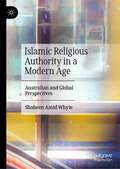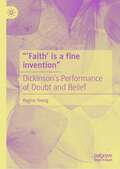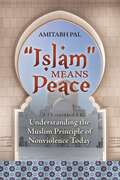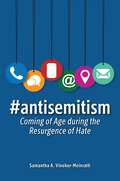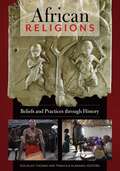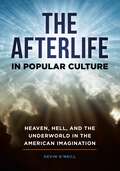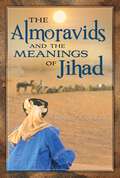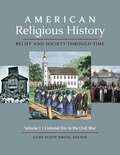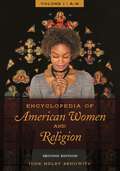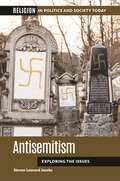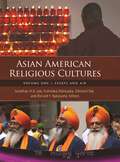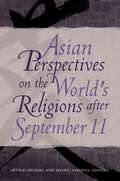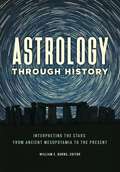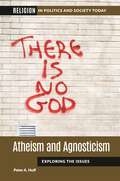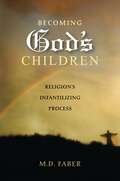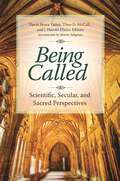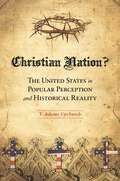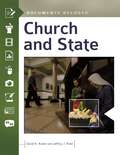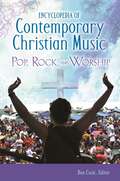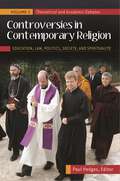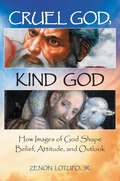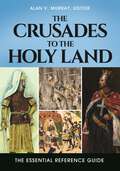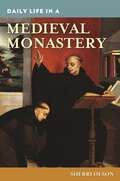- Table View
- List View
Islamic Religious Authority in a Modern Age: Australian and Global Perspectives
by Shaheen Amid WhyteThis book situates Australian Muslim experiences of religious authority within the global context of Islam in the modern world. While drawing on examples of Muslim-majority states, new empirical findings indicate the growing diversity of Muslim religious actors in Australia, as well as the contextual realities shaping the way religious authority is legitimised and contested in democratic and authoritarian environments. In particular, the study challenges homogenous articulations of Islamic religious authority in unearthing new voices, epistemologies and socio-political factors shaping Muslim attitudes and experiences of religious authority. The book fills important gaps in the field, such as intra-Muslim relations, female religious authority, digital Islam and the relationship between traditional ulama, reformists and Muslim intellectuals in the West.
“‘Faith’ is a fine invention”: Dickinson’s Performance of Doubt and Belief
by Regina YoongThis book covers nineteenth-century American poet Emily Dickinson who captured the multifaceted nature of life in all of its uncertainties. Studies on her exploration of faith are ample, but in this book, the author uncovers Dickinson’s playful role-play in enacting solemn themes of religion, death, and the unknown. Dickinson’s creativity encompasses not only her use of language but also her poetic personae and self-created poetic stages inviting readers to question, contemplate deeply or even poke fun at life's absurdities. By using performative roles such as the rejected outcast, passive supplicant, and playful warrior, Dickinson unveils--through a paradoxical framework of belief and unbelief-- a line of inquiry that is multifocal and erratic to “tell all the truth and tell it slant.”
Steps Along the Path
by Ajahn Tate Thanissaro BhikkhuA short handbook on the practice of meditation with tips and recommendations for new and experienced meditators, with a discussion of how best to respond when visions and signs arise.
Buddho
by Ajahn Tate Thanissaro BhikkhuA simple and practical guide to the use of the meditation phrase buddho, which is used to settle the mind to the point at which discernment can begin to arise.
"Islam" Means Peace: Understanding the Muslim Principle of Nonviolence Today
by Amitabh PalThis decisive account of the role of nonviolence in Islam and Muslim societies, both historically and in current times, chronicles an often-obscured but longstanding pacifist tradition."Islam" Means Peace: Understanding the Muslim Principle of Nonviolence Today provides a rebuttal to general misperceptions about the religion by documenting its rich tradition of nonviolence. To that end, the book examines the sources of Islam—the Qur'an, the main religious text of Islam, and the Hadith, the deeds and sayings of the Prophet Muhammad. It contests the prevalent notion that Islam is built on violence in part by illuminating the role of the tolerant, mystical tradition of Sufism in Islam, while at the same time examining the misunderstood place of jihad in the religion. The book is not, however, a historical or theological treatise. Rather, it focuses on the tradition of nonviolence in modern Muslim societies. By spotlighting recent peaceful protest movements in Muslim communities, the book underscores the truly global and multicultural nature of the Islamic tradition of nonviolence. The findings here will be invaluable for Muslims and non-Muslims alike, revealing an alternative tradition both can embrace.
#antisemitism: Coming of Age during the Resurgence of Hate
by Samantha A. Vinokor-MeinrathExploring what it means to come of age in an era marked by increasing antisemitism, readers see through the eyes of Jewish Gen Zers how identities are shaped in response to and in defiance of antisemitism.Using personal experiences, qualitative research, and the historic moment in which Generation Z is coming of age, Jewish educator Samantha Vinokor-Meinrath uses antisemitism from both the political left and the right to explore identity development among Jewish Generation Zers. With insights from educators, students, activists, and more, she holds a lens up to current antisemitism and its impact on the choices and opinions of the next generation of Jewish leaders.Chapters cover Holocaust education for the final generation able to speak directly to Holocaust survivors and learn their stories firsthand; anti-Zionism as a modern manifestation of antisemitism; and how the realities of 21st-century America have shaped the modern Jewish experience, ranging from the synagogue shooting in Pittsburgh to how Generation Zers use social media and understand diversity. The core of this book is a collection of stories: of intersectional identity, of minority affiliations, and of overcoming adversity in order to flourish and thrive.
African Religions: Beliefs and Practices through History
by Douglas Thomas and Temilola AlanamuThis book supplies fundamental information about the diverse religious beliefs of Africa, explains central tenets of the African worldview, and overviews various forms of African spiritual practices and experiences.Africa is an ancient land with a significant presence in world history—especially regarding the history of the United States, given the ethnic origins of a substantial proportion of the nation's population. This book presents a broad range of information about the diverse religious beliefs of Africa that serves to describe the beliefs, practices, deities, sacred places, and creation stories of African religions. Readers will learn about key forms of spiritual practices and experiences, such as incantations and prayer, dance as worship, and spirit possession, all of which pepper African American religious experiences today. The entries also discuss central tenets of the African worldview—for example, the belief that humankind is not to fight nature, but to integrate into the natural environment.This volume is specifically written to be highly accessible to students. It provides a much-needed source of connections between the religious traditions and practices of African Americans and those of the people of the continent of Africa. Through these connections, this work will inspire tolerance of other religions, traditions, and backgrounds. The included selection of primary documents provides users first-hand accounts of African religious beliefs and practices, serving to promote critical thinking skills and support Common Core State Standards.
The Afterlife in Popular Culture: Heaven, Hell, and the Underworld in the American Imagination
by Kevin O'NeillThe Afterlife in Popular Culture: Heaven, Hell, and the Underworld in the American Imagination gives students a fresh look at how Americans view the afterlife, helping readers understand how it's depicted in popular culture.What happens to us when we die? The book seeks to explore how that question has been answered in American popular culture. It begins with five framing essays that provide historical and intellectual background on ideas about the afterlife in Western culture. These essays are followed by more than 100 entries, each focusing on specific cultural products or authors that feature the afterlife front and center. Entry topics include novels, film, television shows, plays, works of nonfiction, graphic novels, and more, all of which address some aspect of what may await us after our passing.This book is unique in marrying a historical overview of the afterlife with detailed analyses of particular cultural products, such as films and novels. In addition, it covers these topics in nonspecialist language, written with a student audience in mind. The book provides historical context for contemporary depictions of the afterlife addressed in the entries, which deal specifically with work produced in the 20th and 21st centuries.
The Almoravids and the Meanings of Jihad
by Ronald A. MessierThis book offers a scholarly, highly readable account of the 11th-12th century rulers of Morocco and Muslim Spain who offered a full range of meanings of jihad and challenged Ibn Khaldun's paradigm for the rise and fall of regimes.Originally West African, Berber nomads, the Almoravids emerged from what is today Mauritania to rule Morocco, western Algeria, and Muslim Spain. Over the course of the century-long lifespan of the Almoravid dynasty, the concept of jihad evolved through four distinct phases: a struggle for righteousness, a war against pagans in the Sahara to impose their own sense of righteousness, war against "bad" Muslims in Sijilmasa and the rest of the Maghrib, and finally, war against Christian infidels—the Christian kings of Iberia.The Almoravids and the Meanings of Jihad takes readers through a clear chronology of the dynasty from its birth through its dramatic rise to power, then its decline and eventual collapse. Several important themes in North African history are explored throughout the book, including the dynastic theory of noted Arab historian Ibn Khaldun, the unique relationship of rural and urban lifestyles, the interactions of distinct Berber and Arab identities, and the influence of tribal solidarity and Islam in forming the social fabric of medieval North African society
American Religious History [3 volumes]: Belief and Society through Time [3 volumes]
by Gary Scott SmithA mix of thematic essays, reference entries, and primary source documents covering the role of religion in American history and life from the colonial era to the present.Often controversial, religion has been an important force in shaping American culture. Religious convictions strongly influenced colonial and state governments as well as the United States as a new republic. Religious teachings, values, and practices deeply affected political structures and policies, economic ideology and practice, educational institutions and instruction, social norms and customs, marriage, and family life. By analyzing religion's interaction with American culture and prominent religious leaders and ideologies, this reference helps readers to better understand many fascinating, often controversial, religious leaders, ideas, events, and topics.The work is organized in three volumes devoted to particular periods. Volume one includes a chronology highlighting key events related to religion in American history and an introduction that overviews religion in America during the period covered by the volume, and roughly 10 essays that explore significant themes. These essays are followed by approximately 120 alphabetically arranged reference entries providing objective, fundamental information about topics related to religion in America. Each volume presents nearly 50 primary source documents, each introduced by a contextualizing headnote. A selected, general bibliography closes volume three.
Encyclopedia of American Women and Religion [2 volumes]: [2 volumes]
by June Melby BenowitzThis two-volume set examines women's contributions to religious and moral development in America, covering individual women, their faith-related organizations, and women's roles and experiences in the broader social and cultural contexts of their times.This second edition of Encyclopedia of American Women and Religion provides updated and expanded information from historians and other scholars of religion, covering new issues in religion to better describe and document women's roles within religious groups. For instance, the term "evangelical feminism" is one newly defined aspect of women's involvement in religious activism. Changes are constantly occurring within the many religious faiths and denominations in America, particularly as women strive to gain positions within religious hierarchies that previously were exclusive to men and rise within their denominations to become theologians, church leaders, and bishops.The entries examine the roles that American women have played in mainstream religious denominations, small religious sects, and non-traditional practices such as witchcraft, as well as in groups that question religious beliefs, including agnostics and atheists. A section containing primary documents gives readers a firsthand look at matters of concern to religious women and their organizations. Many of these documents are the writings of women who merit entries within the encyclopedia. Readers will gain an awareness of women's contributions to religious culture in America, from the colonial era to the present day, and better understand the many challenges that women have faced to achieve success in their religion-related endeavors.
Antisemitism: Exploring the Issues (Religion in Politics and Society Today)
by Steven Leonard JacobsWith an overview essay, timeline, reference entries, and annotated bibliography, this resource is a concise, one-stop reference on antisemitism in today's society.Stretching back to biblical times, antisemitism is perhaps the world's oldest hatred of a group. It has manifested itself around the world, sometimes taking the form of superficially innocent jokes and at other times promoting such tragedies as the Holocaust. Far from disappeared, its continued existence in today's society is evidenced by vandalism of Jewish cemeteries and shootings at synagogues. This book explores the causes and consequences of contemporary antisemitism, placing this form of hatred in its historical, political, and social contexts.An overview essay surveys the background and significance of antisemitism and provides historical context for discussions of contemporary topics. A timeline highlights key events related to antisemitism. Some 50 alphabetically arranged reference entries provide objective, fundamental information about people, events, and other topics related to antisemitism. These entries cite works for further reading and provide cross-references to related topics. An annotated bibliography cites and evaluates some of the most important resources on antisemitism suitable for student research.
Asian American Religious Cultures [2 volumes]: [2 volumes] (American Religious Cultures)
by Jonathan H. X. Lee, Fumitaka Matsuoka, Edmond Yee, and Ronald Y. Nakasone, EditorsA resource ideal for students as well as general readers, this two-volume encyclopedia examines the diversity of the Asian American and Pacific Islander spiritual experience.Despite constituting a fairly small proportion of the U.S. population—roughly 5 percent—Asian Americans are a widely diverse group with equally heterogeneous religious beliefs and traditions. This encyclopedia provides a single source for authoritative information on the Asian American and Pacific Islander religious experience, addressing South Asian Americans, such as Indian Americans and Pakistani Americans; East Asian Americans, including Chinese Americans, Japanese Americans, and Korean Americans; and Southeast Asian Americans, whose ethnicities include Filipino Americans, Thai Americans, and Vietnamese Americans. Pacific Islanders include Hawaiians, Samoans, Marshallese, Tongan, and Chamorro. The coverage includes not only traditional eastern belief systems and traditions such as Buddhism, Confucianism, and Hinduism as well as Micronesian and Polynesian religious traditions in the United States, but also the culture and religious rituals of Asian American Christians.
Asian Perspectives on the World's Religions after September 11
by Arvind Sharma and Madhu KhannaThis book offers a unique perspective on September 11 and our world after this tragic event, sharing lessons from an Asian religious experience that can help heal a world troubled by religious conflicts and deepening divisions, and promote a positive global transformation.Existing literature regarding the events of September 11 and our world afterward has focused mostly on the West and the Middle East. Asian Perspectives on the World's Religions after September 11 extends this discussion to include Asia—a continent and culture far too important to be ignored in any assessment of the global impact of this event. The book is organized along the following themes, as they emerged post-September 11th: religion and civilizational dialogue; religion, conflict, and peace; religion and human rights; religion and ethics; religion and the arts; religion, hermeneutics, and literature; religion and gender; religion and ecology; and religion and globalization. Individuals who are studying or teaching political science, international relations, philosophy, ethics, Asian studies, or religious studies will find the text invaluable, while general readers will appreciate the largely unvoiced Asian perspective on this topic.
Astrology through History: Interpreting the Stars from Ancient Mesopotamia to the Present
by William E. BurnsAlphabetically arranged entries cover the history of astrology from ancient Mesopotamia to the 21st century. In addition to surveying the Western tradition, the book explores Islamic, Indian, East Asian, and Mesoamerican astrology.The field of astrology is growing rapidly, as historians recognize its centrality to the intellectual life of the past and sociologists and anthropologists treat its importance in a number of modern cultures. Despite the historical and cultural significance of the subject, most reference works on astrology focus on instructional techniques and are written by astrologers with little or no interest in the history of the topic. This book instead offers an objective treatment of astrology across world history from ancient Mesopotamia to the present.The book provides alphabetically arranged entries by expert contributors writing on such topics as horoscopes, court astrologers, Renaissance astrology, and comets. While it considers the Western tradition, it also treats Islamic, Indian, East Asian, and Mesoamerican astrology. In doing so, it explores the role of astrology in shaping science, literature, religion, art, and other defining cultural traditions. Sidebars offer excerpts from various historical texts, while entries provide suggestions for further reading.
Atheism and Agnosticism: Exploring the Issues (Religion in Politics and Society Today)
by Peter A. HuffAn overview essay and approximately 50 alphabetically arranged reference entries explore the background and significance of atheism and agnosticism in modern society.This is the age of atheism and agnosticism. The number of people living without religious belief and practice is quickly and dramatically rising. Some experts call nonreligion, after Christianity and Islam, the third largest "religion" in the world today. Understanding the origins, history, variations, and impact of atheism and agnosticism is crucial to getting a grasp of the meaning of the present and gaining a glimpse of the future.Exploring some of the most extraordinary people, events, and ideas of all time, this book provides a fair, comprehensive, and engaging survey of all aspects of contemporary atheism and agnosticism. An overview essay discusses the background and social and political contexts of unbelief, while a timeline highlights key events. Some 50 alphabetically arranged reference entries follow, with each providing fundamental, objective information about particular topics along with cross-references and suggestions for further reading. The volume closes with an annotated bibliography of the most important resources on atheism and agnosticism.
Becoming God's Children: Religion's Infantilizing Process
by M. D. FaberM. D. Faber presents a meticulous, unremitting inquiry into the psychological direction from which Christianity derives its power to attract and hold its followers.Becoming God's Children: Religion's Infantilizing Process was written, its author says, to alert readers to the role of infantilization in the Judeo-Christian tradition generally and in Christian rite and doctrine particularly. Because religion plays such an important role in so may lives, it is essential to understand the underlying appeal and significance of religious doctrines.To that end, Becoming God's Children offers the reader an in-depth account of human neuropsychological development, while unearthing the Judeo-Christian tradition's explicitly infantilizing doctrines and rites. This compelling perspective on the nature and meaning of religious behavior explores issues such as: to what extent religious faith is grounded in the mnemonic recesses of the worshipper's brain, whether believers are predisposed by both genetic makeup and environmental prompting to adhere to their religious convictions, and why some individuals are powerfully drawn to religious faith while others reject it. A final chapter explores the implications of religion's infantilizing process vis-a-vis the role of reason and scientific thought in the contemporary world.
Being Called: Scientific, Secular, and Sacred Perspectives (Psychology, Religion, and Spirituality)
by Martin SeligmanThis unique book is an essential resource for interdisciplinary research and scholarship on the phenomenon of feeling called to a life path or vocation at the interface of science and religion.According to Gallup polls, more than 40 percent of Americans report having had a profound religious experience or awakening that changed the direction of their life. What are the potential mental, spiritual, and even physical benefits of following the calling to take a particular path in life? This standout book addresses the full range of calling experiences, from the "A-ha!" moments of special insight, to pondering what one is meant to do in life, to intense spiritual experiences like Saint Paul on the road to Damascus.Drawing upon the collective knowledge and insight of expert authors from Australia, China, Eastern Europe, Italy, the UK, and the United States, the work provides a comprehensive examination of the topic of callings suitable for collegiate students, professors, and professional scholars interested in topics at the interface of science and religion. It will also benefit general readers seeking the expertise of psychologists, neuroscientists, and theologians from various backgrounds and worldviews who explain why it is important to "do what you were meant to do."
Christian Nation?: The United States in Popular Perception and Historical Reality
by T. Adams UpchurchThis fascinating study examines America's complex and confusing history of arguing with itself over religion and secularism, God and politics, church and state.Hundreds of books are devoted to the ever-timely subject of the separation of church and state in America, but none does exactly what Christian Nation?: The United States in Popular Perception and Historical Reality does. Unlike other studies, this intriguing examination asks the right questions, defines the terms of the debate, explores the widely diverging points of view with equal respect for all sides, and provides insightful commentary and factual conclusions that cut through the clutter.The book begins with several questions: Is the United States a "Christian Nation?" Has it ever been? Was it ever meant to be? What did the Founding Fathers say? How has this issue been interpreted by various individuals and factions over the centuries? The author then surveys the vast literature on this topic, including the U.S. Constitution and Declaration of Independence and the competing and/or complimentary views of various Founding Fathers to arrive at the answers—and, at long last, the truth.
Church and State: Documents Decoded (Documents Decoded)
by David K. Ryden Jeffrey J. PoletThis thoroughly annotated document collection gives students and researchers an authoritative source for understanding the evolving political and legal relationship between church and state from colonial times to the present day.The First Amendment to the Constitution of the United States declares that "Congress shall make no law respecting an establishment of religion, or prohibiting the free exercise thereof." The Establishment Clause, meanwhile, declares a position of neutrality not only between differing religions, but between religious and nonreligious beliefs. The terms of the Free Exercise Clause, however, provide special protections to religious belief and practice. Thus the provisions of the two clauses can clash. In fact, differing political and legal interpretations of these clauses have resulted in some of the most hard-fought and contentious philosophical battles in American history.This book provides readers with convenient access to pertinent documents and court cases that enables a deeper understanding of the past and current balance between church and state and its political implications in the 21st century. The expert commentary that accompanies these key documents serves to elucidate how interpretation of the U.S. Constitution affects issues such as whether public funds or other public support should go to religious-based schools or hospitals; how to safeguard individuals' rights to religious expression while also considering how individuals should not be forced to participate in mandatory religious expressions in public institutions; and how the language regarding "separation of church and state" came about, when this phrase does not appear anywhere in the Constitution.
Encyclopedia of Contemporary Christian Music: Pop, Rock, and Worship
by Don CusicThe first comprehensive overview of contemporary inspirational music, covering its historical roots and dramatic growth into one of America's most vital music genres.The Encyclopedia of Contemporary Christian Music: Pop, Rock, and Worship is the first comprehensive reference work on a form of American music that is far more popular than nonfans may realize. It fills a major gap in the literature on American music and Christian culture, looking at this increasingly popular genre in the context of the overall history of religious music in the United States. With over 200 entries, The Encyclopedia of Contemporary Christian Music covers important performers and industry figures, songs and albums, concerts and festivals, the rise of Christian radio and television, and other issues related to the growth of inspirational music. Scholars and fans alike will find a wealth of revealing information and insightful coverage illustrating the influence of gospel on modern American music with musicians such as Elvis, Sam Cooke, Johnny Cash, Bob Dylan, and U2.The work also examines the use of fundamental rock, pop, and rap music templates in the service of songs of faith.
Controversies in Contemporary Religion [3 volumes]: Education, Law, Politics, Society, and Spirituality [3 volumes]
by Paul HedgesReligious or spiritual beliefs underpin many controversies and conflicts in the contemporary world. Written by a range of scholarly contributors, this three-volume set provides contextual background information and detailed explanations of religious controversies across the globe.Controversies in Contemporary Religion: Education, Law, Politics, Society, and Spirituality is a three-volume set that addresses a wide variety of current religious issues, analyzing religion's role in the rise of fundamentalism, censorship, human rights, environmentalism and sustainability, sexuality, bioethics, and other questions of widespread interest. Providing in-depth context and analysis far beyond what's available in the news or online, this work will enable readers to understand the nature of and reasons for controversies in current headlines. The first volume covers theoretical and academic debates, the second looks at debates in the public square and ethical issues, while the third examines specific issues and case studies.These volumes bring detailed and careful debate of a range of controversies together in one place, including topics not often covered—for example, how religions promote or hinder social cohesion and peace, the relationship of religions to human rights, and the intersection of Buddhism and violence. Written by a range of experts that includes both established and emerging scholars, the text explains key debates in ways that are accessible and easy to understand for lay readers as well as undergraduate students researching particular issues or global religious trends.
Cruel God, Kind God: How Images of God Shape Belief, Attitude, and Outlook (Psychology, Religion, and Spirituality)
by Zenon Lotufo Jr.This enlightening analysis of the image of a cruel God sustained by conservative Christianity reveals how this image formed, the psychological effects of this concept, and the ways in which it has guided religious individuals—in both positive and negative ways.This book is born, in large measure, as a result of a writing by contemporary theologian J. Harold Ellens. In his essay "Religious Metaphors Can Kill" from Praeger's The Destructive Power of Religion, Ellens espouses that theological doctrines are rooted in a model of God that determines all the aspects of those doctrines, and strongly influences the cultures into which it is inserted. Conservative Christianity in the Western world, says Ellens, has at its center the image of a cruel and wrathful God. The juridical atonement theory of Anselm is a result of such an image of God, and has an important role in justifying the resort to violence in human interaction.Starting from these considerations, Cruel God, Kind God: How Images of God Shape Belief, Attitude, and Outlook analyzes three general topics: how two very different kinds of Christianities have emerged from these disparate images of God; how the doctrines of "original sin," "the plan of salvation," and "penal substitution" can be explained by psychological factors, as can the wide dissemination and acceptance of these doctrines; and how the image of a cruel God affects mental health, atrophies personality, and produces guilt and shame.
The Crusades to the Holy Land: The Essential Reference Guide
by Alan V. Murray, EditorBased on the latest scholarship by experts in the field, this work provides an accessible guide to the Crusades fought for the liberation and defense of the Holy Land—one of the most enduring and consequential conflicts of the medieval world.The Crusades to the Holy Land were one of the most important religious and social movements to emerge over the course of the Middle Ages. The warfare of the Crusades affected nearly all of Western Europe and involved members of social groups from kings and knights down to serfs and paupers. The memory of this epic long-ago conflict affects relations between the Western and Islamic worlds in the present day. The Crusades to the Holy Land: The Essential Reference Guide provides almost 90 A–Z entries that detail the history of the Crusades launched from Western Europe for the liberation or defense of the Holy Land, covering the inception of the movement by Pope Urban II in 1095 up to the early 14th century. This concise single-volume work provides accessible articles and perspective essays on the main Crusade expeditions as well as the important crusaders, countries, places, and institutions involved. Each entry is accompanied by references for further reading. Readers will follow the career of Saladin from humble beginnings to becoming ruler of Syria and Egypt and reconquering almost all of the Holy Land from its Christian rulers; learn about the main sites and characteristics of the castles that were crucial to the Christian domination of the Holy Land; and understand the key aspects of crusading, from motivation and recruitment to practicalities of finance and transport. The reference guide also includes survey articles that provide readers with an overview of the original source materials written in Latin, Arabic, Greek, Hebrew, Armenian, and Syriac.
Daily Life in a Medieval Monastery (The Greenwood Press Daily Life Through History Series)
by Sherri OlsonA study of life inside medieval monasteries that explores monastic spirituality, daily routines, contact with the outside world, and the historical impact of these foundational institutions on the Western world.How did the Western monastic tradition begin? What was monastic life typically like for a monk or nun? How was the institution of the monastery formative to Western culture from antiquity through the Middle Ages? This book covers the entire span of monastic history in the late-ancient and medieval periods and provides an in-depth look at several monasteries across Europe. Each chapter introduces the reader to the surviving evidence for the houses studied, such as its monastic rules, plans, records of visitation, chronicles, and biographical accounts; and aims to give an "insider" view—not only of monks' and nuns' daily activities, but what these dedicated individuals' values, ambitions, and aspirations might have been.
